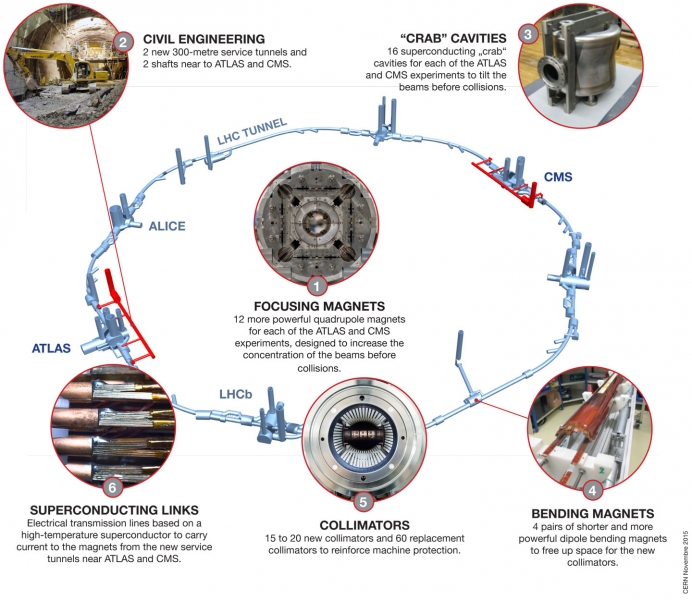The High-Luminosity LHC, which is expected to be operational after 2025, will increase the LHC’s luminosity by a factor of 10. Luminosity is an important indicator of the performance of an accelerator: it is proportional to the number of collisions that occur in a given amount of time. The higher the luminosity, the more data the experiments can gather to allow them to observe rare processes.
To achieve this major upgrade, scientists and engineers are optimising all of the collider’s parameters. Several technologies, some of which are completely innovative, are being developed.

Unprecedented beam optics
Increasing the luminosity means increasing the number of collisions. The aim is to produce 140 collisions each time the particle bunches meet in the centre of the ATLAS and CMS detectors, as opposed to 30 at present. To achieve this, the beam will be more intense and more concentrated than at present in the LHC. One particular challenge will be maintaining luminosity at a constant level throughout the lifespan of the beam. At present, it decreases as the protons collide and disappear. In the High-Luminosity LHC, the beam focusing (the concentration of the beam before impact) will be designed in such a way that the number of collisions remains constant. Other improvements to the beam optics are being studied, like the novel achromatic telescopic squeezing (ATS) scheme, as well as new instrumentation to measure the beam parameters.
More powerful focusing magnets
To increase the number of collisions, the beams will be more focused before they collide. New, more powerful quadrupole magnets, generating a 12-tesla magnetic field (compared to 8 tesla for those currently in the LHC), will be installed either side of the ATLAS and CMS experiments. Twelve of these magnets, made of a superconducting intermetallic compound of niobium and tin will be installed close to each detector. The LHC’s magnets today use a niobium-titanium alloy. (1)
“Crab” cavities for tilting the beams
These superconducting cavities will tilt the particle bunches before collision in order to enlarge the area where they meet by giving them a transverse momentum. Sixteen crab cavities will be installed close to each of the ATLAS and CMS experiments. (3)
Reinforced machine protection
As the beams will contain more particles, machine protection will need to be reinforced. This protection is based on collimators, devices that absorb particles that stray from the beam trajectory and might otherwise damage the machine. New collimators, made from a material that produces less electromagnetic interference on the beam and equipped with new instrumentation, are being developed. Around 60 of the 118 existing collimators will be replaced by new collimators and 15 to 20 new ones will be added. (5)
More compact and powerful bending magnets
The LHC ring is already full of equipment. To allow the insertion of additional collimators, four 15-metre-long dipole magnets will be replaced with four pairs of shorter magnets (each measuring 5.5 metres) and four collimators. These new dipole magnets will be more powerful since they must bend the trajectory of the protons over 11 metres instead of 15. They too are based on the superconducting intermetallic niobium-tin compound and will generate an 11-tesla magnetic field, compared with 8.3 tesla for the current dipole magnets. (4)
Civil-engineering work
Two new 300-metre-long service tunnels will be excavated next to the ATLAS and CMS experimental caverns to house equipment that is particularly sensitive to radiation, such as power converters, which transform alternating current from the electrical network into high-intensity direct current for the magnets. Other equipment, relating to cryogenics in particular, will be moved into these service tunnels. Two new shafts, some 100 metres deep, will also be excavated to allow access to the service tunnels from the surface. (2)
Innovative superconducting transmission lines
Innovative superconducting electrical transmission lines will connect the power converters to the accelerator. These cables will be made from a high-temperature superconducting material, magnesium diboride, which will operate at 20 kelvin and is more stable than other superconductors. They will be able to carry currents of record intensities, up to 100,000 amps! (6)
A renovated accelerator chain
The performance of the LHC and its successor, the High-Luminosity LHC, relies on the injector chain, the four accelerators that pre-accelerate the beams before sending them into the 27-kilometre ring. This accelerator chain is being upgraded as part of the LIU (LHC Injectors Upgrade) project. A major step in the upgrade process will come in 2020 when a new linear accelerator, Linac4, the first link in the chain, will replace the current Linac2. Improvements are also planned for the three other links in the accelerator chain: the PS Booster, the PS and the SPS.
